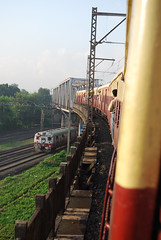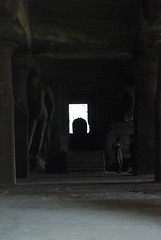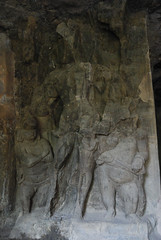 Doug, Cecilia and I decided to make a tour to the Elephanta Caves today.
Doug, Cecilia and I decided to make a tour to the Elephanta Caves today.
It's sunday morning, trains are empty. We bought tickets for second class. It costs 7 Rupees, instead of 70 for the first class. This is what normal people pay, and a lot of them cannot pay even that.
Our clients and Kabi had told us to go early. We took the 9:00 boat for the island from the Gateway of India. It was the first boat of the day. Before it really started it went at first to the other ferries that are parked in the harbour and bring them supplies, while the young men who work and obviously also lives on the boats are clearing themselves and preparing for the new day.
Elephanta Island is a big pleasure to the city of Mumbai. An hour away in the harbour of Mumbai it has no cars, no motorcycles, no taxis or rickshaws. It is silence except the birds crying. We went upstairs and upstairs and came to the first caves, the main cave.
The Elephanta Caves were created sometime between the 9th and the 13th century. It is a major Hindu cave temple complex and dedicated to the god Shiva. It is considered the one of the most perfect Indian art expressions and thus one of the UNESCO World Heritage sites.
 The caves, especially the main cave, contain a lot of huge but partly strong destroyed and partly undiscernable reliefs. The reliefs indeed dipicts the deeds and the various aspects of the god, including he has male and female sides.
The caves, especially the main cave, contain a lot of huge but partly strong destroyed and partly undiscernable reliefs. The reliefs indeed dipicts the deeds and the various aspects of the god, including he has male and female sides.
As I had mentioned a lot of the aspects in the Hindu religion is familiar to me because they have big influance to China. But especially the mythology are not familiar to me. Actually I have almost no knowledge of it at all, although some elements in the mythology are also adapted into Buddhism and thus transfered to China.
I think for someone who is not very interested in art history or archaology or religion the caves are not as impressive as some other caves. Beside of the main cave all the other caves are unfinished or just rudimentary holes. Most sculptures in the main cave are partly destroyed (the guide said by the Portugese). As usually in such cases I feel myself ashamed of not have the knowledge to really appreciate what I see.
 Doug, Cecilia und ich haben beschlossen, heute ein Tour zu den Elephanta Höhlen zu machen.
Doug, Cecilia und ich haben beschlossen, heute ein Tour zu den Elephanta Höhlen zu machen.
Es ist Sontag Morgen. Die Züge sind leer. Wir kauften Karten für Second Class. Es kostet 7 Rupees, anstatt von 70 für First Class. Das ist was normale Leute hier bezahlen, und viele von ihnen sind nicht einmal in der Lager, das zu bezahlen.
Unsere Kunden und Kabi haben uns geraten, früh zu starten. Wir nahmen den 9:00 Boot von Gateway of India zum Elephanta Insel. Es war das erste Boot des Tages. Bevor es wirklich startete, machte es erst einmal einen Rundgang zu den anderen Fähren, die im Hafen parkten und brachte sie Lebensmittel und anderen Notwendigen, während die jungen Männer, die auf den Fähren arbeiten, und offensichtlich auch dort leben, sich gerade wuschen und sich auf den neuen Tag vorbereiteten.
Zur City von Mumbai ist der Elephanta Insel eine große freudige Abwechselung. Eine Stunde entfernt, im Hafen von Mumbai gelegen, er hat keinen Autos, keinen Motorräder, keinen Taxis oder Rickschas. Außer Vogelrufe ist es absolut still. Wir gingen den Treppen hoch und kamen zur ersten Höhle, der Haupthöhle.
Die Elephantahöhlen wurden irgendwann zwischen den 9. und 13. Jahrhundert erschaffen. Es ist ein großes Hinduhöhlentempelkomplex und ist dem Gott Shiva geweiht. Es wird als eine der perfektsten Exemplaren der indischen Kunst betrachtet und wird deswegen als UNESCO Welterbe aufgelistet.
 Die Höhlen, besonders die Haupthöhle, enthält viele große, aber zum Teil stark zerstörten und zum Teil nicht mehr erkennbaren Reliefe. Diese Reliefe zeigen die Taten und unterschiedlichen Aspekten des Gottes, dazu zählen auch dass er männliche und weibliche Seite besitzt.
Die Höhlen, besonders die Haupthöhle, enthält viele große, aber zum Teil stark zerstörten und zum Teil nicht mehr erkennbaren Reliefe. Diese Reliefe zeigen die Taten und unterschiedlichen Aspekten des Gottes, dazu zählen auch dass er männliche und weibliche Seite besitzt.
Wie ich bereits erwähnt habe sind viele Aspekte der Hindureligion für mich vertraut, da sie große Einflüsse auf China ausgeübt haben. Aber besonders die Mythologie ist mir nicht vertraut. In der Tat weiß ich so gut wie nichts davon. Nur einigen Elementen werden von Buddhismus adaptiert und so nach China transportiert.
Ich glaube, für Leute, die sich nicht für Kunstgeschichte, Archäologie oder Religion interessiert, sind die Höhlen nicht so bemerkenswert wie einigen anderen Höhlen. Außer der Haupthöhle sind allen anderen Höhlen noch unvollendet, manche sogar sind noch rudimentäre Löcher. Die meisten Reliefe in der Haupthöhlen wurden zum Teil zerstört (der Guide sagt von den Portugiesen). Wie immer in solchen Fällen fühle ich mich beschämt weil ich nicht genug Wissen besitze, um das Gesehene zu würdigen.
 我和Doug、Cecilia决定今天去看象岛石窟。
我和Doug、Cecilia决定今天去看象岛石窟。
由于是周日早晨,车很空。我们买了二等舱的车票。只花了7卢比。一等舱要70卢比。7卢比是一般人出的钱,虽然如此还有许多人出不起。
我们的顾客和Kabi都说我们应该早走。因此我们搭乘九点的船从印度门去象岛。 因为是早上头班船,因此在出发前它首先去巡游港口里停泊的其它摆渡船,给它们运送补给。船上工作的年轻人显然也住在船上,正在梳洗准备当天的工作。
相对于孟买市来说离城市一小时远的象岛太舒适了。这里没有汽车、摩托车、出租车或者三轮车。除了鸟叫以外一片宁静。我们随阶梯向上爬,走到第一座石窟,也是主石窟。
象岛石窟是9至13世纪间建造的。它是一个巨大的印度教石窟庙宇,是供奉湿婆的。它被看作是印度艺术精华的典范之一,因此被列入联合国教科文组织世界遗产。
尤其主石窟里含有许多巨大的浮雕。有些这些浮雕破坏严重,有些无法辨别了。这些浮雕现实大神的各种经历和他的不同表现,包括他有男女两面。
如我已经说过印度教的许多观点对我来说不陌生,因为它们对中国有很大的影响。但是对印度教的神化我没有了解,应该说一无所知。不过一些元素被佛教采纳传入中国。
 我想对于对艺术史、考古学或者宗教不感兴趣的人象岛石窟不如其它一些石窟那么可观。除主窟外其它石窟都没有完成,有些甚至还是原始的窟窿。主窟内的大多数浮雕部分被毁(导游说是葡萄牙人做的)。在这种情况下我总是觉得因为知识不足,无法感受所见,而非常惭愧。
我想对于对艺术史、考古学或者宗教不感兴趣的人象岛石窟不如其它一些石窟那么可观。除主窟外其它石窟都没有完成,有些甚至还是原始的窟窿。主窟内的大多数浮雕部分被毁(导游说是葡萄牙人做的)。在这种情况下我总是觉得因为知识不足,无法感受所见,而非常惭愧。

No comments:
Post a Comment